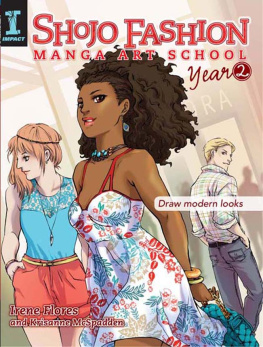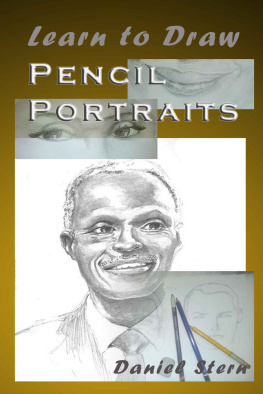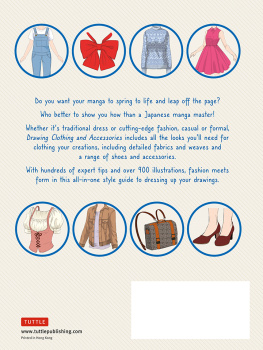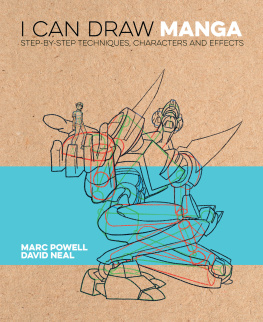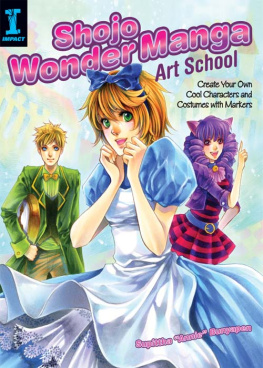Shojo Fashion
Manga Art School
Year 2
Draw Modern Looks
Irene Flores and
Krisanne McSpadden




Shopping List
Surface
Deleter Plain B comic book paper patterned papers for backgrounds
Pencils
mechanical pencils
regular mechanical pencil lead
blue mechanical pencil lead
drawing pencils
Pens + Markers
gel pens
felt-tip pens
brush pens
Tools
ruler
eraser
French curve
drafting templates
Miscellaneous
scanner
Adobe Photoshop
sketchbook


Introduction
When creating Shojo Fashion Manga Art School Year 1that is to say, the first book!we hit upon something that we felt was underrepresented, not only in the world of art guides, but manga and comic art in general. Clothing. We found it difficult to find manga or comic books with colorful, unique, creative, realistic clothing. Clothes that change every day, because most characters have more than one outfit. Clothes that get ripped or dirty in realistic ways. Clothes that say something about a characters personality.
For Year 2, weve created a manga-style how-to-draw book centered entirely around clothes. In the following pages you will find information on casual clothing, clothing for going out, work clothes, school clothes and even how to design your own school uniform. From prom to weddings, and sports to seasonal, we have covered the basics for manga in a modern-day setting. Youll find tips on every step of the process and hundreds of pieces of art to use for your own reference.
While this book is by no means exhaustivehow could it be? It would take thousand of pages!we have done our best to create something worthy of a spot on your shelf. And with any luck, this expedition into the world of clothing in manga/comic mediums will continue in Year 3 .
Pens, Pencils and Paper
All you really need for drawing is a pen and paper, so dont get overwhelmed by the huge market of available art supplies. Here are a few tools I prefer to draw with. Experiment and see what you prefer, or what you can afford.

blue lead
MECHANICAL PENCILS
Mechanical pencils are great because you dont have to bother with sharpening them. I always keep one of my pencils filled with blue lead. This makes it easier to go over sketches with darker graphite or ink. Also, blue lead tends to disappear when scanned, leaving the darker pencil or ink lines without having to erase all of the preliminary sketching.

SCANNING YOUR SKETCHES
Sketch a drawing with blue pencil or ink, then lay in your preliminary inks. When you scan the image using the black-and-white setting, the blue sketch lines disappear.

BRUSH PEN
My preferred pen is a brush pen, which gives me varying line weight without having to go over the same spot numerous times.

GEL AND FELT-TIP PENS
Use gel pens and felt-tip pens for straight lines and to fill in large areas. Trying to make lines with a brush pen and ruler can be messy and difficult.

DRAWING PAPER
I like using Deleter Plain B comic book paper because my brush pens dont bleed as much and ink dries very fast. The dimensions vary slightly from standard U.S.-sized paper, but it still fits my scanner.
Other surfaces such as printer paper, bristol or posterboard will also work as long as they hold lead and ink. Use what you like and what works best with your drawing tools.

MONOTONE PLAID
When drawing a plaid in monotone, convey the idea of different colors by varying the types of lines used. (In this case, two narrow lines, one thick line, one thin line and one thin dotted line.)

READY-MADE PATTERNS
Ready-made patterns (usually black and white) can save you time drawing patterns and textures for clothing, buildings and backgrounds. However, its difficult to make the patterns move with the natural folds of a garment when applied to clothing. Thats something to think about when deciding whether or not to create your own patterns.
Patterns
You dont need fancy, expensive paper to draw. Whether its printer paper, thick bristol paper or posterboard, if it will hold lead and ink, it is good. However, some paper will work better with the tools you prefer than others. Experiment and see what you prefer, or what you can afford.

Scan Backgrounds From Patterned Paper
Scan scrapbook or origami paper to digitally create unique backgrounds. Or re-create the patterns by hand.
CREATE A MONOTONE PLAID PATTERN

Use thick hatched lines and double narrow lines.

Criss-cross a second set of double narrow lines.


